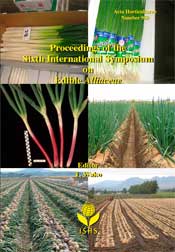Ver ítem
- xmlui.general.dspace_homeCentros Regionales y EEAsCentro Regional Mendoza - San JuanEEA La ConsultaArtículos científicosxmlui.ArtifactBrowser.ItemViewer.trail
- Inicio
- Centros Regionales y EEAs
- Centro Regional Mendoza - San Juan
- EEA La Consulta
- Artículos científicos
- Ver ítem
Yield stability of ten garlic (Allium sativum) clonal cultivars in northern Patagonia, Argentina
Resumen
Since 1989, the Garlic Project of INTA (The National Institute of Agricultural Technology, Argentina) has obtained an important number of clonal cultivars by means of clonal selection. Those high yielding and top quality cultivars allow extending the technological alternatives for the industry. However, all those clones have been obtained in a same location (La Consulta, Mendoza; 33.70°S; 69.7°W, 950 m a.s.l.) and little is known about their stability of
[ver mas...]
Since 1989, the Garlic Project of INTA (The National Institute of Agricultural Technology, Argentina) has obtained an important number of clonal cultivars by means of clonal selection. Those high yielding and top quality cultivars allow extending the technological alternatives for the industry. However, all those clones have been obtained in a same location (La Consulta, Mendoza; 33.70°S; 69.7°W, 950 m a.s.l.) and little is known about their stability of response in environments outside the main producing region. The aim of this work was to study yield stability of clonal cultivars from different ecophysiological groups (EG), all selected at 33.70°S, in promising locations for garlic production around northern Patagonia. Throughout 2005-2008 ten clones were proven in four sites. Each year the seed was provided from the site of origin of the clones (Experiment Station La Consulta). Cultivars studied were Morado INTA (EG-II); Lican INTA , Norteño INTA , Nieve INTA , Perla INTA and Unión (EG-III); Gostoso INTA , Fuego INTA and Sureño INTA (EG-IVa); Castaño INTA (EG-IVb). Sites for the survey were Cinco Saltos (Río Negro; 38.82°S; 68.7°W, 290 m a.s.l.), Hilario Ascasubi (Buenos Aires; 39.38°S 62.62°W, 15 m a.s.l.), Viedma (Río Negro; 40.78°S; 63.5°W, 9 m a.s.l.) and Trevelin (Chubut; 43.12°S; 71.52°W, 360 m a.s.l.). Bulb weight (g per plant) was analyzed by AMMI and SREG models through the software InfoGen. Although Morado INTA belongs to the EG-II (subtropical climate adaptation) it showed higher yields among clones proven in northern Patagonia (62.73 g on average), besides highly unstable. Clones of EG-III produced an intermediate and more stable response (bulb mean weight about 50 g). Gostoso INTA gave the worst yield across all locations. The four sites in this study, although contrasting in latitudes and seasonal temperatures, would be considered belonging to a same mega-environment.
[Cerrar]

Autor
Descripción
Presentado al VI International Symposium on Edible Alliaceae
Fuente
Acta Horticulturae 969 : 107-112. (2012)
Fecha
2012-12
Editorial
International Society for Horticultural Science
ISSN
0567-7572
Formato
pdf
Tipo de documento
artículo
Palabras Claves
Derechos de acceso
Restringido
 Excepto donde se diga explicitamente, este item se publica bajo la siguiente descripción: Creative Commons Attribution-NonCommercial-ShareAlike 2.5 Unported (CC BY-NC-SA 2.5)
Excepto donde se diga explicitamente, este item se publica bajo la siguiente descripción: Creative Commons Attribution-NonCommercial-ShareAlike 2.5 Unported (CC BY-NC-SA 2.5)

